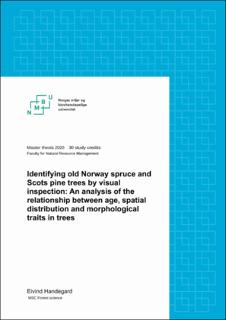| dc.contributor.advisor | Gjerde, Ivar | |
| dc.contributor.advisor | Bollandsås, Ole Martin | |
| dc.contributor.author | Handegard, Eivind | |
| dc.coverage.spatial | Norway | en_US |
| dc.date.accessioned | 2020-09-24T11:08:05Z | |
| dc.date.available | 2020-09-24T11:08:05Z | |
| dc.date.issued | 2020 | |
| dc.identifier.uri | https://hdl.handle.net/11250/2679452 | |
| dc.description.abstract | Old trees are important to biodiversity, yet they are in global decline. In Scandinavia, due to former forest management, old trees were declining, but now possibly on the rise. In Norway, identification of old trees has been incorporated as part of forest planning in the form of Old-tree habitats. The Old-tree habitats are management units, which in turn can be given the status of woodland key habitat. Forest planners delimit Old-tree habitats during fieldwork based on visual characteristics detailed in a field guide. This study aimed to evaluate if the Old-tree habitats on average contained higher densities of old Norway spruce and Scots pine trees compared to surrounding mature forests. Furthermore, the validity of the variables in the field guide was tested. In addition to tree variables, site variables detailing environmental conditions and proxies for anthropogenic influence were assessed.
The research design consisted of 373 trees sampled from 37 localities in four municipalities in southeastern Norway. On each locality, the age of the five oldest trees in an Old-tree habitat was sampled along with a corresponding reference plot situated in neighboring forests. Tree level variables and site variables were collected during fieldwork and through GIS. The age difference between the Old-tree habitats and surrounding mature forests were tested using a pairwise t-test. Three different types of age models were included: models for single trees, stand-level models fitted with tree variables, and stand-level models using site variables. These were mainly developed as mixed models
The Old-tree habitats were, on average 43 years older than neighboring mature forests. Old trees were present at each locality, but the density and age of the oldest trees in the Old tree habitats were higher than the reference plots. The single tree model for Norway spruce was weak, whereas the respective model for Scots pine had moderately explanatory power. The Stand level model tree based models for the species both explained a moderate amount of variance. The most consistent morphological trait for both models was bark structure, size-related variables were, however, generally weakly correlated with the age. The site-based models were weakly correlated with age. | en_US |
| dc.description.abstract | Gamle trær er viktig for det biologiske mangfoldet, likevel er de i nedgang globalt. Grunnet tidligere skogforvaltning var gamle trær i Skandinavia tidligere i nedgang, men denne negative trenden har muligens snudd. I Norge har registreringen av gamle trær blitt inkludert som en del av skogbruksplanleggingen igjennom MIS (Miljøregistrering i skog) livsmiljøet «Gamle trær». «Gamle trær» figureres ut ved hjelp av visuelle kjennetegn nedtegnet i feltinstruksen til MIS. Formålet med denne studien var å evaluere hvorvidt «Gamle trær» inneholdt flere gamle trær sammenlignet med hogstmoden skog i nærheten. Videre, ble validiteten til beskrivelsene av gamle trær i feltinstruksen vurdert. I tillegg til dette ble bruken av areal baserte variabler testet for å vurdere effekten av ulike miljøforhold og menneskelig påvirkning. | en_US |
| dc.language.iso | eng | en_US |
| dc.publisher | Norwegian University of Life Sciences, Ås | en_US |
| dc.rights | Attribution-NonCommercial-NoDerivatives 4.0 Internasjonal | * |
| dc.rights.uri | http://creativecommons.org/licenses/by-nc-nd/4.0/deed.no | * |
| dc.subject | Forest | en_US |
| dc.subject | Old trees | en_US |
| dc.subject | Forest ecology | en_US |
| dc.subject | Forest management | en_US |
| dc.title | Identifying old Norway spruce and Scots pine trees by visual inspection : an analysis of the relationship between age, spatial distribution and morphological traits in trees | en_US |
| dc.type | Master thesis | en_US |
| dc.description.version | submittedVersion | en_US |
| dc.subject.nsi | VDP::Matematikk og Naturvitenskap: 400::Zoologiske og botaniske fag: 480::Plantefysiologi: 492 | en_US |
| dc.source.pagenumber | 54 | en_US |
| dc.description.localcode | M-SF | en_US |

